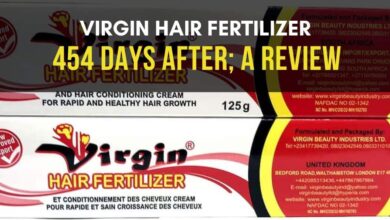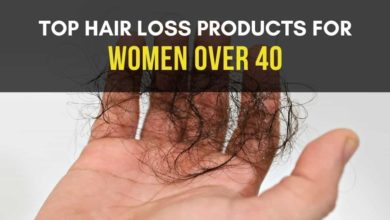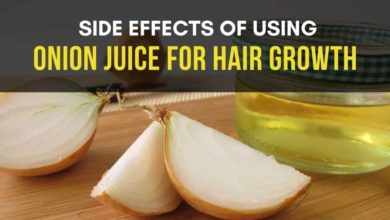Head and Shoulders Ingredients (Complete List & Effects Explained)
Hi there. In today’s post, we will be discussing the Head and Shoulders ingredients, their functions, and their potential side effects.
There are lots of anti-dandruff shampoos made by different brands all over the world, and all of them have some unique ingredients that help fight dandruff effectively. No doubt, Head and Shoulders anti-dandruff shampoo is one of the most popular out there in its category.
This article includes affiliate links. This implies that I may receive a small commission if you make a purchase through these links. You can find detailed disclosure information at the bottom of the page.
Head and Shoulders have tons of five-star reviews on Amazon and other marketplaces, it’s essential to note that it isn’t suitable for all hair types, as it contains the following ingredients:
- Sulfate
- Fragrance and
- Alcohol
According to Healthline;
“While sulfates are effective at removing dirt and oil from your hair, the problem is that these ingredients can be way too strong for some people. You may not respond well to sulfates if you have sensitive skin or hair, or if you have any allergies or sensitivities to these types of chemicals.”
So, right off the bat, it’s clear that Head and Shoulders’ sulfate content makes it too strong for a lot of people, excluding them from its list of potential users, but what else does it have that you may want to watch out for? This Head and Shoulders ingredients list should serve as a guide.
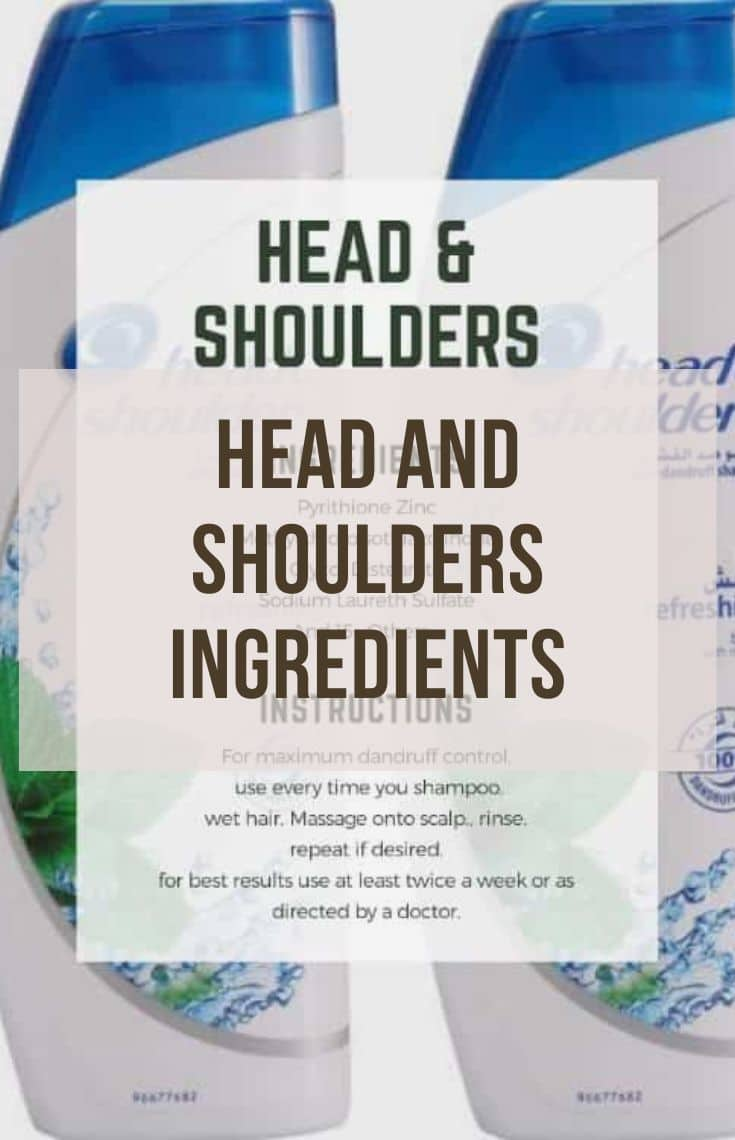
Quick Bites:
- Read My Honest Review On Dexe Black Hair Shampoo
- Virgin Hair Fertilizer Increased This Ladies Hair length by 4 inches in 13 days.
Head and Shoulders Ingredients
From the shampoo’s packaging, here’s a list of all ingredients in Head and Shoulders:
Methylchloroisothiazolinone, Guar Hydroxypropyltrimonium Chloride, Sodium Xylenesulfonate, Sodium chloride, Magnesium Sulfate, Magnesium Carbonate Hydroxide, Ammonium Laureth Sulfate, Benzyl Alcohol, Water, Fragrance, Blue 1 and Red 4, DimethiconeCetyl Alcohol, Glycol Distearate, Zinc Carbonate, Cocamide MEA, Sodium Laureth Sulfate, Sodium Lauryl Sulfate, and Pyrithione Zinc.
NOTE: This the updated list of ingredients in head and shoulders shampoo as said by the giant manufacturer as at 2023.
Methylchloroisothiazolinone (INACTIVE)
Methylchloroisothiazolinone (MCI) is a powerful preservative with antibacterial and antifungal properties common in liquid and semi-liquid skin and hair care products. It’s relatively safe and inactive, so you don’t really have to worry about it, although it routinely triggers allergic reactions in certain individuals.
However, a concentration of 15 ppm in rinse-offs products and 8 ppm in cosmetics are considered safe for use.
Functions In H&S: Preserves the shampoo after opening.
Methylisothiazolinone (INACTIVE)
Methylisothiazolinone is a synthetic biocide and preservative. Its primary responsibility is to inhibit the growth of bacteria.
Functions In H&S: It also works with Methylchloroisothiazolinone to preserve the shampoo after opening and use.
Guar Hydroxypropyltrimonium Chloride (INACTIVE)
Guar Hydroxypropyltrimonium chloride is considered a safe, biodegradable, and non-irritant component of shampoos to combat hair static.
It is very beneficial to hair care products because it is positively charged or cationic. It neutralizes the negative charges on hair strands that cause hair to become static or tangled.
Better yet, it does this without weighing the hair down. With this ingredient, you can have silky, non-static hair that retains its maximum volume.
Functions In H&S: Prevents static and helps to detangle the hair.
Sodium Xylenesulfonate (INACTIVE)
Sodium Xylenesulfonates is a surfactant used in detergents and shampoos, and it amounts up to 10% of the product.
They are surfactants: and for mixtures like shampoo, this ingredient is used to thicken, and help keep some other ingredients in the solution.
This ingredient makes the product clear or transparent, by decreasing the surface tension between the separate ingredients in the shampoo.
Sodium Xylene Sulfonate is rated a low hazard ingredient by the Cosmetics Database; it has mild concerns regarding organ system toxicity and skin and eye irritation, but beyond that, it’s a relatively safe ingredient.
Functions In H&S: Helps adjust shampoo thickness and reduces surface tension to make it easier to disperse.
Sodium chloride (INACTIVE)
The viscosity of the aqueous (water) portion of the cosmetic, shampoo, and personal care products can be adjusted with Sodium Chloride.
Functions In H&S: Sodium chloride helps adjust the shampoo’s viscosity to prevent an excessively watery texture.
Magnesium Sulfate (INACTIVE)
Magnesium Sulfate is a non-reactive. Other solids ingredients a product can be diluted with Magnesium Sulfate, Manufacturers also use it to increase the volume of hair care products.
Sodium Benzoate (INACTIVE)
Sodium benzoate is an effective preservative, fragrance ingredient, and corrosion inhibitor in hair products and cosmetics. It is considered safe (GRAS) by the Food and Drug Administration in the United States, and the story is similar in most other countries.
Magnesium Carbonate Hydroxide (INACTIVE)
Magnesium Carbonate Hydroxide is a basic inorganic carbonate. It serves as a bulking agent, pH Adjuster, binding, viscosity controlling agent.
Functions In H&S: Helps stabilize zinc carbonate in the shampoo.
Ammonium Laureth Sulfate (INACTIVE)
ALS is classified as an alkyl sulfate, and an anionic surfactant found primarily in shampoos and body wash as a foaming or lathering agent to help remove impurities from the hair.
However, upon eye contact, this compound may cause severe irritation, but you don’t want to go around dropping shampoo in your eyes, do you?.
Benzyl Alcohol (INACTIVE)
Benzyl can act as a fragrance component, preservative, solvent, and viscosity-decreasing agent in so many cosmetic formulations.
Furthermore, it sometimes acts as a local anesthetic and antimicrobial agent.
Water (INACTIVE)
It’s not something that needs an explanation. Water (Aqua) is the most crucial ingredient in any haircare product, especially when it’s a shampoo. Also, in case you’re wondering, it’s safe, otherwise we’d be all dead.
Fragrance (INACTIVE)
Head and Shoulders shampoo’s fragrance comes from multiple ingredients. Some prominent ones include amyl Cinnamal, benzyl salicylate, citronellol, hexyl Cinnamal, limonene, linalool, and menthol. They’re all safe and serve no purpose than to give the shampoo its characteristic sweet smell.
Blue 1 and Red 4 (INACTIVE)
They are both synthetic colorants combined to act as a color agent in Head and Shoulders shampoo.
Cetyl Alcohol (INACTIVE)
Cetyl Alcohol acts as an emulsifying agent or an emulsifier, that is, It helps two components to mix, typically used to create a suspension of a hydrophilic and hydrophobic substances like oil and water.
Dimethicone (INACTIVE)
This ingredient acts as a hair conditioning agent. that is, ingredients that enhance the appearance and feel of hair, by increasing hair volume, suppleness, or sheen.
Dimethicone is one of the ingredients that helps improve the texture of damaged hair.
Glycol Distearate (INACTIVE)
Glycol Distearate is added to cosmetics or hair products to increase the visual appeal of the product, but it also acts as a skin moisturizer, an emulsion stabilizer, and a thickening agent.
Zinc Carbonate (INACTIVE)
Zinc carbonate is an inorganic salt that serves as an opacifying agent and skin protectant.
Functions In H&S: Helps keep anti-dandruff ingredients active.
Cocamide MEA (INACTIVE)
In shampoos, Cocamide MEA and other cocamide ethanolamines such as cocamide DEA can be used as foaming agents and nonionic surfactants.
Functions In H&S: Acts as lathering or foaming agent.
Sodium Laureth Sulfate and Sodium Lauryl Sulfate (INACTIVE)
SLES is a very active foaming agent and surfactant. And many cosmetic products depend on this ingredient for their cleaning and emulsifying properties.
FAQs On Head And Shoulders Ingredients
Q: What is the active ingredient in Head and Shoulders shampoo?
The most active ingredient in head and shoulders shampoo is Pyrithione Zinc; this is because it fights the dandruff-causing microbe, Malassezia Globosa, and stops them from forming scalp irritants.
Q: What are the disadvantages of Head and Shoulders shampoo?
The shampoo contains sulfate, a surfactant that decreases friction between your hair and the shampoo, to make it easier to apply. However, sulfate also appears to remove the hair’s essential oils, generally making it hard to recommend for most people.
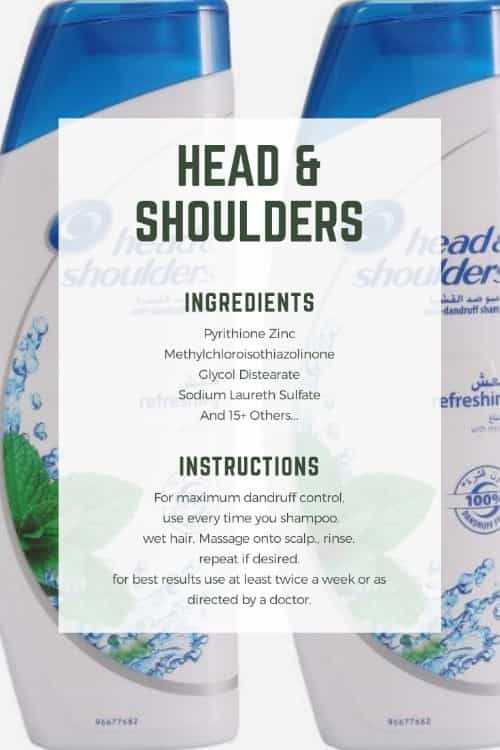
Now I would love to hear from you:
What do you think about this list of Head and shoulders ingredients?
Or maybe you have opinions or experiences to share with us here?
Either way, do let us know by leaving a comment below right now, and don’t forget to share with friends.
If you liked this post, here are some other recommendations you may want to check out:
- Dexe Black Hair Shampoo Review: Before And After
- 10 Best Children’s Shampoo for Itchy Scalp
- 7 Best Curly Girl Friendly Shampoo To Buy: Without Breaking The Bank
Pin for Later

References
- https://en.m.wikipedia.org/wiki/Methylchloroisothiazolinone
- https://www.forceofnatureclean.com/chemical-free-living-methylisothiazolinone/
- https://sci-toys.com/ingredients/xylenesulfonate.html
- https://cosmeticsinfo.org/ingredient/magnesium-sulfate-0
- https://en.m.wikipedia.org/wiki/Ammonium_lauryl_sulfate
- https://en.m.wikipedia.org/wiki/Benzyl_alcohol
- https://cosmeticsinfo.org/ingredient/dimethicone
- https://en.m.wikipedia.org/wiki/Cocamide_MEA

